Ganja and Hess is a movie that sticks with me, it’s something of an obsession. I’ve watched it at least five times, and I’m constantly looking for information about both the movie, and its director, Bill Gunn. The strange thing is that I’m not even sure if I like this movie or not. To be honest, the film is nonsensical, and kind of boring. Gunn is more obsessed with ideas and imagery than with narrative, and while this isn’t exactly a bad thing, the film’s obliqueness can turn off even the most pretentious cinephile.
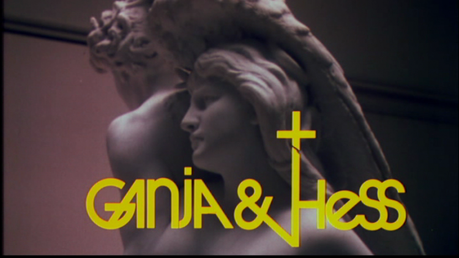
Yup, This Was Made In The 70s
The film follows Dr. Hess Green (Duane Jones), professor of archeology, geology, and anthropology, who is studying the fictional ancient African culture of Myrthia. The Myrthians had a strange fascination with blood, and were said to bleed their slaves dry so they could drink their essence and therefore live forever. Helping in his studies is the mentally unstable George Meda (Bill Gunn), a suicidal drunk who–for reasons unknown–stabs Hess three times (one for the father, one for the son, and one for the holy ghost), and then commits ritualistic suicide. This doesn’t kill Hess though; instead it makes him a blood addict who can neither die, nor be killed. At first disgusted by his addiction, Hess begins to see it as simply a part of his life, and even begins to kill others to get his fix. Eventually, George’s wife, Ganja (Marlene Clark) comes looking for her husband, but soon forgets all about him when she realizes the obscenely rich Hess is in love with her. What she doesn’t realize is that when Hess says he wants to be with her forever, he means it.
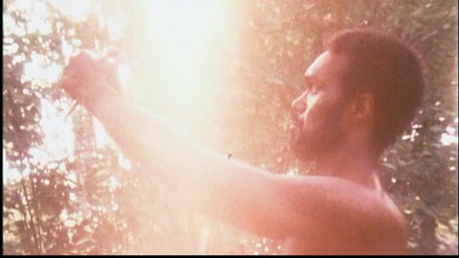
Nothing Says “I Love You” Like Ritualistic Murder
Speaking solely in terms of plot, the film doesn’t seem too out there, and really, it isn’t. This film could have easily been accessible to mainstream audiences, but the way the story is presented is what makes Ganja and Hess so strange. First of all, the information I gave you about Myrthia isn’t in any dialogue in the film; rather, it’s in a song that plays during the opening credits. And no, the music isn’t exactly in the forefront either, and I didn’t realize the song held so much critical information until I listened to the second commentary track on the film. Even then, most of the film is left unexplained, specifically the events surrounding George stabbing Hess. We never know if George knew about the Myrthian curse, or if he was just crazy. This is the films biggest weakness, and the major reason why it is such an obscure entry in the vampire canon.
As I stated before, this is a film of ideas as opposed to story, and Gunn has two main themes running through his film: addiction, and the relationship between African Americans and Christianity. Vampire films are no strangers to the theme of addiction (heck, there’s even a vampire film called The Addiction [1995]), and really, this aspect is probably the least interesting idea explored in this film. The main thesis on this theme is that an addict is more of a victim than a victimizer, which, while a major crux in the film, seems somewhat shallow.
More interesting is the role of Christianity in the film. The opening scene is of a minister (Sam Waymon) preaching to a choir. We come to learn that he is also Hess’ part time chauffer/groundskeeper, who–while not a major part– features heavily in the climax of the film. Religious imagery abounds: most tellingly in the scene where Hess drinks blood for the first time, which juxtaposes images of Hess with a picture of Jesus, and ends with a cross floating in a bathtub.
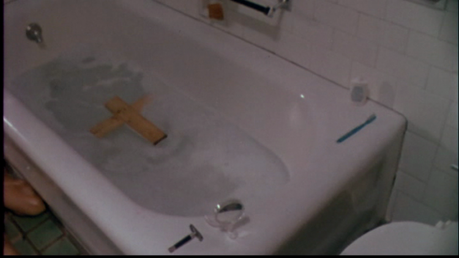
Wooden Crossy, You’re The One, You Make Bath Time Lots Of Fun
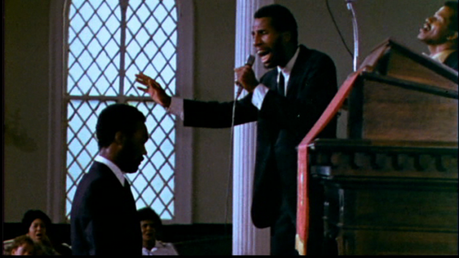
And ye shall be HEALED!
Tied with the concept of Christianity is the social construction of race; specifically race and class. Interestingly enough, while Gunn wanted to show a black man who was sophisticated and cultured, there seems to be a few unfortunate implications running around this portrayal. The easiest way to show Hess as educated is to show him as obsessed with European culture: he speaks French, his house is filled with European objets d’art, even the credits take place against a backdrop of Greco-Roman statuary displayed at the museum he works in. His contented world is disrupted by a savage curse from his roots, signaled by a dream where he is beckoned away from a suited white man towards an African queen wearing an elaborate headdress; when he wakes up, George attacks, and Hess is cursed. What can defeat this curse? The cross, and while the church that’s shown is a black one, it’s very interesting to see the clash between an African religion (represented in a negative light), and the positive portrayal of Caucasian-dominated Christianity. Even more interesting is the fact that Hess goes almost exclusively after lower income African Americans, as if his curse is making him crave to act more “black”, himself.
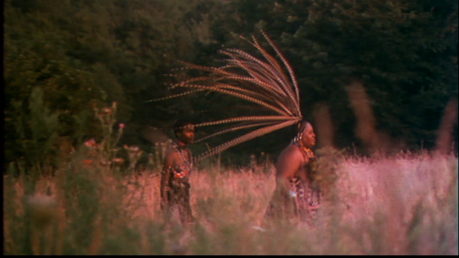
The Myrthians May Have Been Crazy Blood Addicts, But They Had Awesome Hats
Ganja and Hess is not a bad film, just a strangely told one. It plays with a lot of interesting themes, but instead of presenting these themes overtly, it conveys them with cinematography and music. Fortunately, both the cinematography and music are extraordinary, but the lack of a cohesive plot means that thinking about the film after the fact is actually more fun than watching the film itself. This isn’t a film for everyone, or the vast majority of the population for that matter, but if you want to watch a film that will fill your thoughts long after you watch it, this is a film for you.
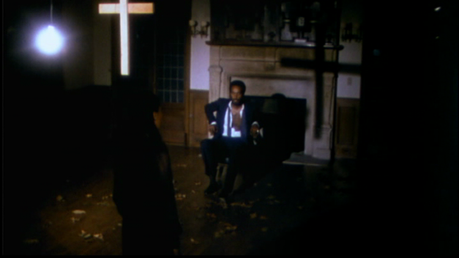
The Vampires One True Weakness: Dramatic Lighting

